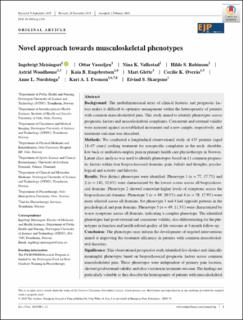| dc.description.abstract | Background: The multidimensional array of clinical features and prognostic factors makes it difficult to optimize management within the heterogeneity of patients with common musculoskeletal pain. This study aimed to identify phenotypes across prognostic factors and musculoskeletal complaints. Concurrent and external validity were assessed against an established instrument and a new sample, respectively, and treatment outcome was described. Methods: We conducted a longitudinal observational study of 435 patients (aged 18–67 years) seeking treatment for nonspecific complaints in the neck, shoulder, low back or multisite/complex pain in primary health care physiotherapy in Norway. Latent class analysis was used to identify phenotypes based on 11 common prognostic factors within four biopsychosocial domains; pain, beliefs and thoughts, psychological and activity and lifestyle. Results: Five distinct phenotypes were identified. Phenotype 1 (n = 77, 17.7%) and 2 (n = 142, 32.6%) were characterized by the lowest scores across all biopsychosocial domains. Phenotype 2 showed somewhat higher levels of symptoms across the biopsychosocial domains. Phenotype 3 (n = 89, 20.5%) and 4 (n = 78, 17.9%) were more affected across all domains, but phenotype 3 and 4 had opposite patterns in the psychological and pain domains. Phenotype 5 (n = 49, 11.3%) were characterized by worse symptoms across all domains, indicating a complex phenotype. The identified phenotypes had good external and concurrent validity, also differentiating for the phenotypes in function and health-related quality of life outcome at 3-month follow-up. Conclusion: The phenotypes may inform the development of targeted interventions aimed at improving the treatment efficiency in patients with common musculoskeletal disorders. Significance: This observational prospective study identified five distinct and clinically meaningful phenotypes based on biopsychosocial prognostic factors across common musculoskeletal pain. These phenotypes were independent of primary pain location, showed good external validity, and clear variation in treatment outcome. The findings are particularly valuable as they describe the heterogeneity of patients with musculoskeletal pain and points to a need for more targeted interventions in common musculoskeletal disorders to improve treatment outcome. | en_US |

